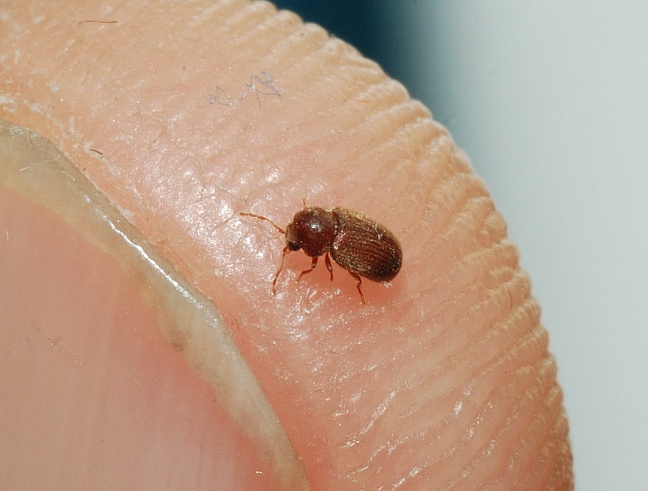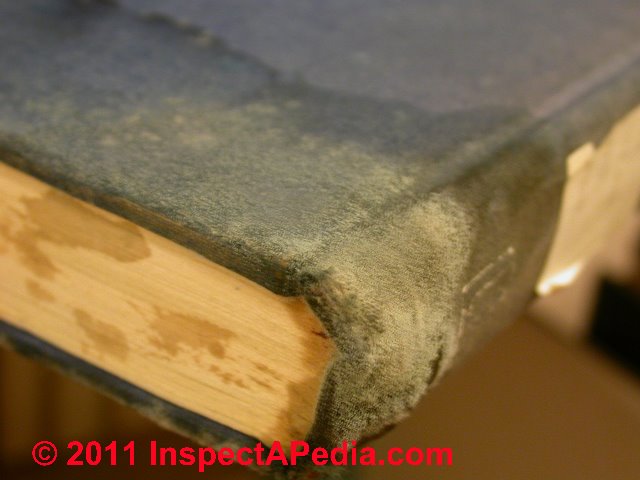I recently made an extreme bookshelf cleaning and I found some unexpected and unwanted visitors.
Bookworms are a real problem and most of us aren't aware of them. They are not the worm-with-glasses we see in images around.

They are nasty little creatures that feed on your books. YES. A bug may be eating your books right now.
So what are these creatures?? I'll explain below each book threat.
1. A major book-feeding insect is the "book lice" or "paper lice" (they are NOT real lice). These are tiny (under 1 mm), soft-bodied wingless insects which actually feed on microscopic molds and other organic matter found in ill-maintained works (e.g., cool, damp, dark, and undisturbed areas of archives, libraries, and museums), although they will also attack bindings and other book parts.
A Book louse in comparison to a penny
Damage by moths
3. Leather-bound books attract various other consumers, specially beetles.
The bacon or larder beetle is roughly 7 to 9 millimetres in length. The rear of the body is pale with black spots, while the rest of the body dark brown. The larvae feed on leather bindings and, when fully fed, bore into the text blocks of books to construct a pupating chamber.
The bread or biscuit beetle (Stegobium paniceum) is a small (2 millimetres) reddish brown insect with very small larvae. The larvae feed on starch materials, especially the rice or flour paste used on end sheets and book spines.
The cigarette beetle (Lasioderma serricorne) is a small, light-brown flying beetle that commonly infests books. The beetle's larvae are one of the types popularly known as bookworms, with eggs laid on the spine of a book and along the edges. Immediately upon hatching, the larvae tunnel under the binding cover, especially down the spine area. The insect then proceeds to tunnel up to 10 centimetres into the paper text, where it pupates into an adult beetle. The adult leaves a round exit hole, as well as powdered paper on the shelf. One of this beetle's favourite foods is dried flowers and spices!
The larvae of the drugstore beetle (Stegobium paniceum) are also often referred to as bookworms. This beetle is found in moist storage areas, and the larvae can actually tunnel all the way through books, from one cover to the other. As with the cigarette beetle, piles of paper powder signal that this insect is active.
A drugstore beetle.
3. Bedbugs can also hitch a ride in books and reproduce there, specially hardcover ones. This article of The New York Times comments on the issue of increasing numbers of bedbugs in libraries. This is not an actual threat to books but they can cause nasty rashes and allergies in humans.
Bedbugs
4. Now, the visitors I found were not so good looking. I declared war on the order Thysanura. The insects from this order have a preference for polysaccharides and sugary foods. Most of them live outside under leaf piles and rocks, but others live inside our homes. The home-y include silverfish and firebrats. They actually don't pose any threat to human health and don't transmit any disease, but they actually EAT BOOKS.
A grown up silverfish
Silverfish are the biggest problem in my bookshelf. Thankfully, I found few and the damages made by them are minimal. Lepisma saccharina, commonly known as a silverfish or fishmouth, is a small, wingless insect. Its common name derives from the animal's silvery light grey and blue colour, combined with the fish-like appearance of its movements, while the scientific name (L. saccharina) indicates the silverfish's diet of carbohydrates such as sugar or starches. Silverfish consume matter that contains polysaccharides, such as starches and dextrin in adhesives. These include book bindings, carpet, clothing, coffee, dandruff, glue, hair, some paints, paper, photos, plaster, and sugar and tapestries. Other substances they may eat include cotton, dead insects, linen, silk, or even its own exuvia or exoskeleton. They can survive up to one year without food.
You must not only look for the insect itself but also look for markings, like scrapings, notches, and holes on books, wallpapers, and photos.
Book damaged by silverfish
5. Although it's not a pest, molds may also damage your books in many ways by rotting and disintegrating your pages. It will also attract bugs which in turn will continue to damage your books. Molds and algae are also an alert since they need a humid environment to grow. If you have a humid environment enough for molds, you will have other insects which in turn need high humidity to survive, such as silverfish.
A mouldy book
6. Termites . By far the most damaging of all insects are termites, abundant in tropical regions. The damage to all paper-based materials can be catastrophic, in that entire collections can be rendered useless by the severe nature of the attack. There are three main types of termites: drywood, dampwood, and subterranean. Termites eat all cellulose materials, including wood, paper, binding cloth, and binding board.
Now what do you do when you have one of these guys living in your bookshelf?
Solutions
First of all, if you see any bug while cleaning or checking books, KILL IT.
Also, take your books outside for fresh air and sunlight. Most of these guys are nocturnal and hate light and heat, so they will flee or die. Re-check your books after drying up in the sun.
For bed bugs, the main solution to put an end on this is to clean your own home constantly. Bedbugs hate fresh air and sunlight. Washing your bed covers, blankets, pillow covers and plushie toys every month is the perfect solution. Clean your floors, vacuum your rugs and dust your sofas. There are also some sprays that kill these bugs. Try to search for one made using natural ingredients.For a larger infestation, call pesto control.
For termites, some protection can be given by the building design (use of metal shielding over wooden foundations, painting any exposed wood), but the best remedy is cleanliness, prevention of moisture, and constant vigilance. Termite infestations can usually only be dealt with through the use of pesticides applied by a qualified operator. There has been some success with buried traps that attract subterranean termites.
If you live in a tropical area like me, consider natural pest controls. For example, giving a spider a home on your bookshelf. Earwigs, house centipedes, and spiders are known to be predators of silverfish.It may sound creepy, but I actually had a spider living in my bookshelf as a book guardian but unfortunately, it passed away without my knowing, so silverfish started reproducing. Many of you may hate spiders, but they are really good natural pest controllers and they eat ants, mosquitoes, silverfish, moths, etc.
IMPORTANT: Before giving one a secure, warm home in your bookshelf, please check in the web or with an expert the type of spider it is, to make sure that they aren't poisonous or do any kind of damage (bites, rashes) to people/pets. I usually search in the web for the description that fits with the one I have and put them in the bookshelf once I know that they don't pose any kind of threat. If it's not the one, I usually carry it to a park about 1 km from my house and release it (it isn't their fault they are harmful in houses).
Buying a dehumidifier is a very good solution and the most efficient one if you want to prevent any more bugs roaming around your books. If you take the humidity away, very few of these guys will be able to survive. The size of the dehumidifier depends on the size of the room and bookshelf. There are many prices in the market that adjust to your wallet.
This is the one I bought for about $45.
If the books are way too infested, put the books in Ziploc bags and freeze them for 1-2 days.
If you buy books, take care of them!
Investing in book health is crucial for our precious books to last longer.
References and more info:
I've added some links in the text itself. Here are the rest of my sources which you can read for more info.Cornell Library Pests and Pest Control
Orkin: silverfish
Wikipedia
Buzzle: getting rid of Silverfish
DIY pest control
Wiki How paper mites pest control










Bookworms with extensive collection of books in their house could relate to this problem. With the presence of timeworn papers and wooden bookshelves around, it is expected that there’ll be tiny creatures who would be inhabiting around your collection. Of course that wouldn’t be the case if you’re the type who dutifully check and clean your throngs of books and the shelves they’re in. It will not only protect you from those bugs and mites, but also prolong your book's lifespan. Cheers!
ReplyDeleteJoshua Harvey @ Invader
Joshua,
DeleteYes! We, human bookworms, suffer the attacks of pests such as these. Aside from the material of the bookshelf and stacked old papers and books, there are many environmental variables to take into account. For example, if you live in a very humid area (like me) or the amount of sunlight your booksleves recieve. Still, it is highly recommended to clean your bookslef every couple of months to kill/avoid wanted visitors. Luckily, I just found a few silverfish in mine since they have the perfect environment for reproduction here.